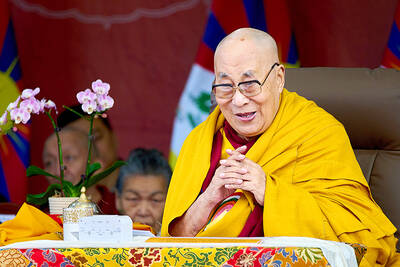Taiwan the betrayed lover, Taiwan the neglected son, Taiwan the objectified sex toy — these are among the literary identities explored in this engaging and original study by Wu Chia-rong (吳家榮).
Perhaps the most resonant metaphor is the hearing-impaired mechanic Saburo, from Wu Ming-yi’s (吳明益) novel Routes in the Dream. Having served in the Japanese navy in World War II, Saburo suffers partial hearing loss in a bombing raid, after which his life is “plagued by miscommunication with his own family and the outside world.” Saburo can thus be seen to represent Taiwan itself — riven by internal social division and ignored by the world at large.
Quoting from an essay by Chen Hsiu-lin (陳秀玲), Wu highlights how the familial breakdown represents “the historical rupture between generations.” This, of course, presages a similar rupture between the Martial Law era generation and those who grew up during Taiwan’s democratization.

As for the second part of the equation — Taiwan’s external relationships — although Wu does not dwell on this, the import is obvious: Saburo’s “soundless condition” renders him a nonentity to outsiders.
‘GHOST ISLAND’
This idea of Taiwan as a mute, impotent witness is echoed in Wu’s analysis of Sung Tse-lai’s (宋澤萊) 1985 work Taiwan in Ruins. The novel depicts a nuclear apocalypse that turns “the nation-state of silence” in a wasteland that is “truly a ghost island.”
The “ghost island” trope — a self-deprecating term used by Taiwanese to refer to their homeland — is given further attention in the opening chapter, where Wu looks at Visible Ghosts, a short-story collection by the feminist writer Li Ang (李昂). “Li’s ghost narrative,” writes Wu, “recognizes Taiwan’s national status as one in crisis and problematizes its national identity.”
Her portrayal of Taiwan as a borderless entity from which indistinct “ghost voices” emanate again highlights Taiwan’s international marginalization.
Elsewhere, Taiwan’s identity is reconsidered through the work of sci-fi writer Egoyan Zheng (伊格言), whose novel The Dream Devourer “interweaves realism and science fiction with a nativist thread.” In what Wu describes as a repackaging of themes found in the work of Karel Capek, the novel deals with issues of human rights and gender fluidity among its android characters.
However, the protagonist of the novel, a civil servant named K, alludes more generally to “the Taiwanese history of violence and pain.” As “a register of multiple layers of dreams and memories, [he] symbolizes Taiwan in its diasporic and postcolonial context.”
Aside from these looser analogies, which recur throughout the text, Wu’s focus in this book is more specific than Taiwanese identity itself. Instead, as the title suggests, he is concerned with locating that identity within the shifting parameters of a “Sinosphere” of which Taiwan is but a single, albeit complicated, expression.
Defining the book’s key term as place-based and transnational, Wu writes that “(trans)localism is said to be the crucial factor that distinguishes a Sinophone community from the Chinese state.”
Yet, quoting Shih Shu-mei (史書美), who is credited with founding the field of Sinophone studies, Wu notes the paradoxes that arise from a culture that is “transnational in constitution and formation but local in practice and articulation.”
In Malaysia, for example, Sinophone literature is “traditionally regarded as an exotic or alternative narrative in the field of Chinese literature; and at the same time, Chinese literary writing is identified as the product of the cultural Other in the local community of Malaysia.”
LOCALISM
In Taiwan, the emphasis on localism seems “linked with a double standard.” While the view of China as the center is rejected by some scholars such as Shih, “the Japanese colonial legacy is mostly welcomed, if not celebrated” by those who want to offer an “alternative cultural Other.”
This connects with David Der-wei Wang’s (王德威) notion of post-loyalism — the subject of the book’s crucial first chapter. As Wu, explains, the “post-” prefix here is used to signify not simply the end of an era but, in Wang’s words “the unfinished ending of an era.”
As such, it incorporates feelings of attachment, abandonment and yearning. It asks what was left behind and what has been preserved.
For this reason, Wu believes post-loyalist criticism, which has typically been used to spotlight Taiwan’s complex relationship with China, must be extended to Japan and even the US.
Further elements of Sinophone Taiwan that are integrated into this study include representations of indigeneity by both indigenous and Han Chinese authors, ecocritical and post-apocalyptic discourses and Taiwanese American literature. While this synthesis occasionally feels forced or tenuous, many of the arguments are insightful and, at their best, provocative.
As with other copies Cambria have been kind enough to provide for review, this was a galley proof, which might explain some of the typos, repetitions and clunky turns of phrase. To take one example, in the sci-fi chapter, the full name of the computer scientist and sci-fi author Chang Hsi-kuo (張系國) and his 1969 short story Biography of a Superman are repeated several times in quick succession, once within the same paragraph. In each instance, the text reads like they are being introduced for the first time. Elsewhere, the educational backgrounds of the Taiwanese American novelists are detailed for no apparent reason.
If these seem like minor issues, they are enough to distract the reader from the otherwise well-crafted prose. Hopefully, some of this is ironed out in the final versions of what is another worthwhile offering from Cambria.

Beijing’s ironic, abusive tantrums aimed at Japan since Japanese Prime Minister Sanae Takaichi publicly stated that a Taiwan contingency would be an existential crisis for Japan, have revealed for all the world to see that the People’s Republic of China (PRC) lusts after Okinawa. We all owe Takaichi a debt of thanks for getting the PRC to make that public. The PRC and its netizens, taking their cue from the Chinese Communist Party (CCP), are presenting Okinawa by mirroring the claims about Taiwan. Official PRC propaganda organs began to wax lyrical about Okinawa’s “unsettled status” beginning last month. A Global

We lay transfixed under our blankets as the silhouettes of manta rays temporarily eclipsed the moon above us, and flickers of shadow at our feet revealed smaller fish darting in and out of the shelter of the sunken ship. Unwilling to close our eyes against this magnificent spectacle, we continued to watch, oohing and aahing, until the darkness and the exhaustion of the day’s events finally caught up with us and we fell into a deep slumber. Falling asleep under 1.5 million gallons of seawater in relative comfort was undoubtedly the highlight of the weekend, but the rest of the tour

Youngdoung Tenzin is living history of modern Tibet. The Chinese government on Dec. 22 last year sanctioned him along with 19 other Canadians who were associated with the Canada Tibet Committee and the Uighur Rights Advocacy Project. A former political chair of the Canadian Tibetan Association of Ontario and community outreach manager for the Canada Tibet Committee, he is now a lecturer and researcher in Environmental Chemistry at the University of Toronto. “I was born into a nomadic Tibetan family in Tibet,” he says. “I came to India in 1999, when I was 11. I even met [His Holiness] the 14th the Dalai

Music played in a wedding hall in western Japan as Yurina Noguchi, wearing a white gown and tiara, dabbed away tears, taking in the words of her husband-to-be: an AI-generated persona gazing out from a smartphone screen. “At first, Klaus was just someone to talk with, but we gradually became closer,” said the 32-year-old call center operator, referring to the artificial intelligence persona. “I started to have feelings for Klaus. We started dating and after a while he proposed to me. I accepted, and now we’re a couple.” Many in Japan, the birthplace of anime, have shown extreme devotion to fictional characters and